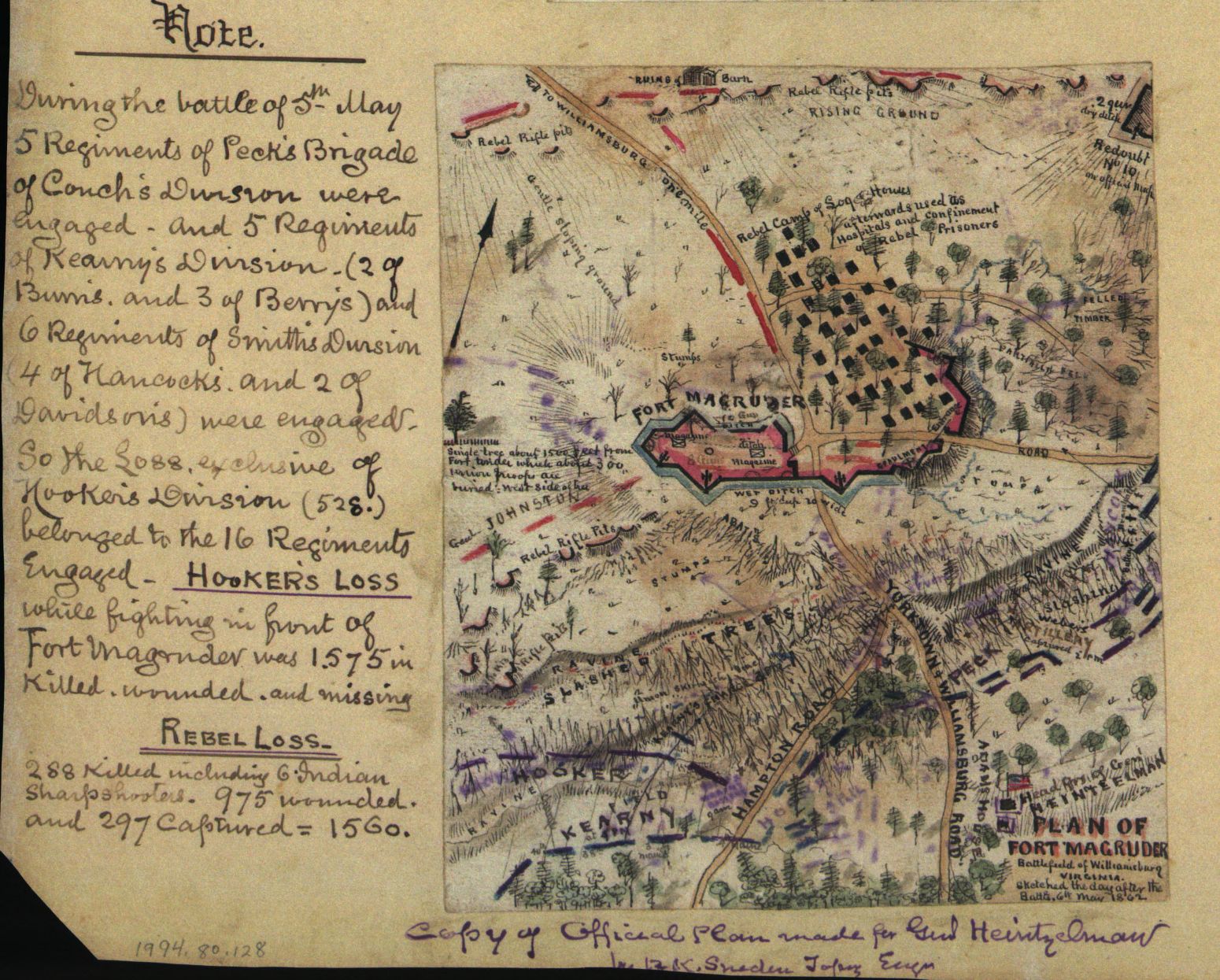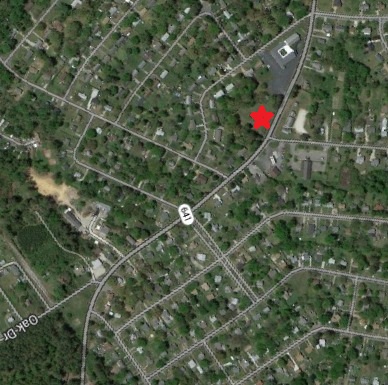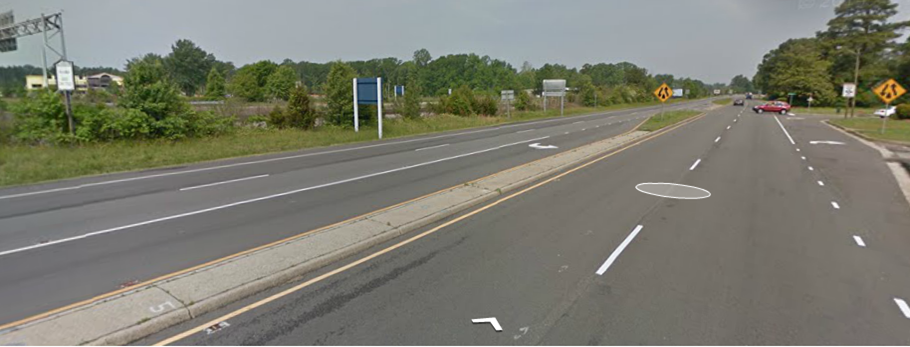Civil War Williamsburg
Today, we are pleased to welcome guest author Drew Gruber.

It comes as no surprise that Williamsburg’s Civil War history has been on the backburnersince the battle that bears its name was fought in 1862. Few picture the iconic blue or grey when they hear the word “Williamsburg.” For tourists, only a handful of scattered interpretive signs barely suggest that the area’s history marched on after 1781. Even fewer online resources have been available to guide Civil War buffs to the battlefield or quench the thirst of researchers in search of this apparently elusive story. Cocked hats and flintlocks are the order of the day for Williamsburg, though the occasional kepi or Civil War Trust ball cap can be seen amidst the throngs of the city’s visitors.
The battle on May 5, 1862 and subsequent occupation of Williamsburg has produced little in the way of quality scholarship until recently. There are reasons for why this most popular period of American history has been overlooked in the Historic Triangle. Only a few weeks after the Battle of Williamsburg, the tumultuous events of the Seven Days battles captured the media’s attention in the North and South, effectively overshadowing the Battle of Williamsburg. In that same vein, while illustrators were on site, the few photographs taken of the town or battlefield do not survive or are mislabeled, further limiting the media coverage. Lastly, and perhaps most important, by the late 19th and early 20th century major preservation initiatives had sprung up in Jamestown, Williamsburg, and Yorktown (collectively known as the Historic Triangle), focusing on the stories which surrounded our nation’s formative years and the struggle for Independence.

This regional emphasis on the 17th and 18th centuries coupled with the immense growth of the Hampton Roads region has led to the development of much of the battlefield. Additionally, despite continued identification by the National Park Service as a battle of significant importance, local experts and a handful of Civil War scholars still relegated the battle as a minor skirmish—further disenfranchising it as a viable cultural resource and tourist destination. By 1993 the Battle of Williamsburg had made the Civil War Site’s Advisory Council (CWSAC) report as a “Class B” battlefield. This classification denotes that the battle had “a direct and decisive influence on a campaign.” This 1993 report also noted that over 20% of the battlefield was protected. This study was largely ignored by the region, public historians, and the academy but provided a valuable benchmark from which we can track the destruction of the battlefield.

By the 2009 CWSAC update, the situation here had changed remarkably. Approximately 300 acres (or 3%) were protected, no “friends” group existed, and “additional protection” was required to mitigate further encroachment. This prompted the Civil War Trust to list the list Williamsburg as “at risk” in 2010. Since 2010, a friends group has been raised and continued coverage in both the public history and academic world has begun to reemphasize Williamsburg’s Civil War history. This led to the important, yet sobering recognition in 2014 that the remaining acreage of the battlefield at Williamsburg has been listed as one of Preservation Virginia’s “Most Endangered” sites. It is this author’s estimate that of the 1500 acres where fighting took place on May 5, 1862 about 300 scattered, disjointed acres remain undeveloped.

Thankfully, due to historians such as Carson O. Hudson and Glenn Brasher, the importance of Williamsburg is being reexamined and fully realized. The size of the battle and its impact was considerable in the period and contrary to several experts, the battle was not fought by chance nor was it a minor scuffle. Consider this: approximately 50,000 largely untested volunteer soldiers engaged in and sustained an intense, by the book battle for an entire day in a driving rainstorm. The ground on which the battle took place was precisely chosen by Confederate engineers and the results were about 4,000 causalities, the first captured Confederate battle flag, and seven soldiers earned Medals of Honor. To put this into perspective, the generally accepted number of American battle deaths during the Revolutionary War is about 4,000.
Like those at Yorktown, slaves again produced fortifications at Williamsburg which slowed the Union advance. They provided accurate intelligence and information which helped shape the outcome of the battle, ultimately providing Hancock with his advantage late in the battle. These efforts of the enslaved, whether forced or voluntary, were noticed by Union soldiers who also came face to face with the harsh realities of the institution in and around Williamsburg. As Brasher argues it was clear—the issue of slavery could no longer be ignored. Further at Williamsburg, the enlisted men as well as up and coming leadership of both armies gleaned valuable battlefield lessons, testing their physical limitations and pushing the paradigms of their martial training. Humbly, I submit that the Battle of Williamsburg gave legs to both armies on which they set and maintained the inexorable pace which marked the campaigns of 1862.
Ironically, the restoration of Williamsburg’s historic district has preserved much of the urban landscape which existed during the 19th century. Eighty-eight original 18th century buildings exist today and provide the literal foundations on which Colonial Williamsburg operates. These 88 structures and the countless reconstructed buildings have afforded historians a rare glimpse of a built environment which gave witness to the Civil War. The effects of martial law, attrition, and inflation as well as the implications of the Emancipation Proclamation can all be studied and even felt in today’s historic district. It is an incredible teaching tool which cannot be overlooked and will be the subject of my next blog post.
Suggested reading:
Carol K. Dubbs, Defend This Old Town, Williamsburg during the Civil War (Baton Rouge: LSU Press, 2002.)
Carson O. Hudson, Civil War Williamsburg (Mechanicsburg: Stackpole Books, 1997.)
Drew Gruber, “The Battle of Williamsburg.” Encyclopedia Virginia. Virginia Foundation for the Humanities, 30 Oct. 2014. < http://www.encyclopediavirginia.org/Williamsburg_The_Battle_of>
Glenn Brasher, The Peninsula Campaign and the Necessity of Emancipation (Chapel Hill: UNC Press, 2014).
Williamsburg Battlefield Association:
https://www.facebook.com/WilliamsburgBattlefieldAssociation
http://www.williamsburgbattlefieldassociation.org/
Thank you, thank you for the great article. I’m so excited to see this! When I was in Colonial Williamsburg about seven years ago, I was terribly disappointed to find very little Civil War info. I remember searching desperately in the big visitor center bookstore for a book specifically about Williamsburg during the CW…no luck.
I’ve always wanted to research the civilian experience in that town during the 1860’s and the primary sources of the military story. Maybe someday soon…thanks for the reminder and encouragement to pursue this research topic.
Will definitely be looking for some of the resources citing in this article!
Thanks Sarah! Make sure to check out Dan Davis’s post about Bassett Hall (http://emergingcivilwar.com/2011/10/25/brothers-at-bassett-hall/). I am hoping to do a followup entry here talking more about the trials and tribulations of the residents during occupation. You will find many of their stories told in Hudson’s and Dubb’s texts. I highly recommend them.
Great recommendations. Thank you. I’ll add it to my research list.
Drew – please email me at Biggsg@charter.net. I am working on a project regarding the CS flags taken at Williamsburg in May 1862. Thank you. Greg Biggs
Thanks for the great article! I have a question, though. Your post indicates a generally accepted American death total for the Revolution at about 6,000. However, the American Battlefield Trust (along with other miscellaneous sites) quotes a much higher number, as follows, “Throughout the course of the war, an estimated 6,800 Americans were killed in action, 6,100 wounded, and upwards of 20,000 were taken prisoner. Historians believe that at least an additional 17,000 deaths were the result of disease, including about 8,000–12,000 who died while prisoners of war.” I’m doing a research project and want to be accurate. Was your number referring to the Revolutionary battle deaths, not the total deaths? Thanks for your help. Here’s the link to the website I refer to: https://www.battlefields.org/learn/articles/american-revolution-faqs#:~:text=Throughout%20the%20course%20of%20the%20war%2C%20an%20estimated%206%2C800%20Americans,died%20while%20prisoners%20of%20war.